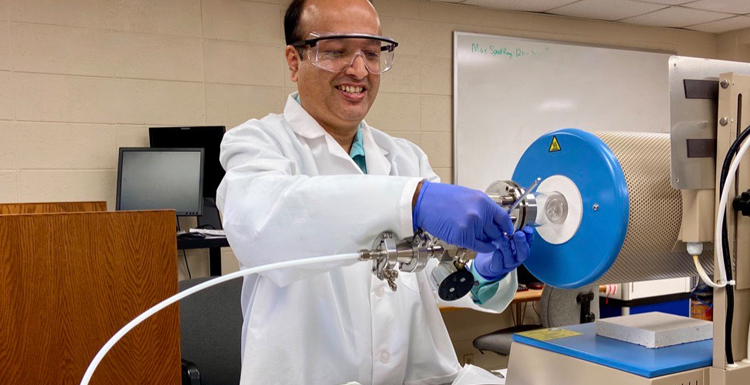South Professor Receives NSF Grant to Study Clean Energy
Posted on August 16, 2023

The University of South Alabama’s Dr. Arjun Dahal, an assistant professor in the Department of Physics, has been awarded a $300,893 grant by the National Science Foundation for his research on developing clean energy through heterostructure photocatalysts.
“Scientific breakthroughs in developing innovative and green energy technologies can move economies away from fossil fuels,” Dahal said. “As hydrogen is regarded as a promising ‘green fuel,’ its production from the photocatalysis process by splitting water utilizing sunlight and photocatalyst materials is a promising method of generating clean energy. Designing innovative photocatalyst materials is the primary step to realize efficient hydrogen production.”
Dahal’s research aims to design efficient, low-cost and innovative photocatalyst materials. Through his research, Dahal is developing new ways to produce composite photocatalyst materials using two-dimensional metal oxides and 2D transitional metal dichalcogenides.
“2D materials are those that extend in one plane like a piece of paper but are only a single atomic or molecular layer thick,” Dahal said. “Due to the synergistic effects of 2D zinc oxide and tungsten disulfide, the composite photocatalyst material can potentially be more efficient than conventional photocatalyst materials. After preparing the composite photocatalyst materials, we will investigate how its water-splitting efficiency can be further improved by investigating the roles of the various material’s properties.”
Specifically, Dahal’s research group is studying fabrication methods to prepare composite materials incorporating 2D zinc oxide and 2D tungsten disulfide. By researching and finding different materials to split water to produce hydrogen, Dahal is creating sustainable clean energy with non harmful byproducts, a major win for the environment, while also training students in cutting-edge nanoscale science within the context of modern energy and environmental applications.
“The grant can support two undergraduate students throughout three years of project duration,” Dahal said. “The research project is strongly interdisciplinary, which teaches students physics and chemistry concepts.”
Dahal’s project, titled “2D-WS2 Supported 2D-ZnO Nanoislands for Visible-Light-Driven Photocatalysis” is funded through the National Science Foundation by the Chemical Catalysis Program in the Division of Chemistry and the Established Program to Stimulate Competitive Research.





